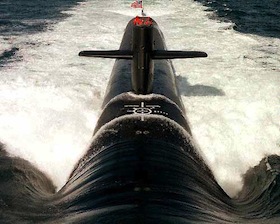Debating the Future Role of the Nuclear Sub
June 21, 2011
Featured Image
Today's top nuclear policy stories, with excerpts in bullet form.
Stories we're following today: Tuesday, June 21, 2011.
The Submarine That Might Save America - Loren Thompson in Forbes [link]
- As threats evolve and the number of weapons are limited by arms control agreements, the [US nuclear] triad [of bombers, submarines, and ICBMs] may become a dyad, or even a so-called “monad” — in other words, a single type of highly survivable weapon.
- That brings me to the most expensive program in the “Obama nuclear buildup,” the [Ohio-class ballistic missile submarine] replacement program…it looks likely to carry the preponderance of U.S. nuclear warheads during the middle portion of the century, roughly from 2030 to 2080, and therefore to be the most important part of the deterrent force.
- Construction of the new sub will cost over $5 billion annually in the next decade at a time when the Navy will need to replace other types of warships...
- The Obama Administration’s Nuclear Posture Review displaced strategic deterrence from its top position in the nation’s nuclear agenda, substituting a focus on proliferation and terrorism — a clear signal that the fears motivating construction of the Ohio class have waned.... [But] The day may well come when America [uses its dozen submarines in a high stakes rivalry with Russia or China].
US Hits Iranian Shipping with Sanctions - AFP [link]
- In slapping sanctions on 10 shipping companies and three individuals linked to the Islamic Republic of Iran Shipping Lines, the Treasury said it was "responding to Iran's continued efforts to evade sanctions and its ongoing creation and use of new front companies, subsidiaries and affiliates to protect IRISL and to advance its proliferation activities."
- Treasury designated IRISL in September 2008 for providing logistical services to Iran's Ministry of Defense and Armed Forces Logistics, which oversees the country's ballistic missile program.
Hosue Calls for Los Alamos Plutonium Lab Slowdown - By John Fleck in the Albuquerque Journal [link]
- A key House Committee last week told federal nuclear weapons program managers they need to work out earthquake safety issues before beginning construction on a new plutonium lab complex at Los Alamos.
- The appropriations bill is being billed as a “cut” to overall the nuclear weapons program, but that is relative. It would provide $7.09 billion for Fiscal Year 2012, a 3 percent increase over this year but $497 million less than the Obama administration had requested.
- For New Mexico, the highest-profile item is money for the Chemistry and Metallurgy Research Replacement project. The administration requested $300 million, the committee only was willing to provide $200 million.
India Weighs Developing ICBM With 6,200-Mile Reach - Global Security Newswire [link]
- Informed insiders said the chief aim of developing an ICBM would be to prevent an attack by neighboring China, which has significantly increased its own military spending in recent years
- Currently, Indian policies do not permit production of missiles with ranges in excess of 3,100 miles.
- Only China, Russia, the United Kingdom and the United States today possess an ICBM strike capability.
B61 Mod 12 Revisited - Jeffrey Lewis in Arms Control Wonk [link]
- I just want to focus on that car analogy. You know the one — the habit of labbies the world over to compare nuclear weapons under a test ban to cars you aren’t allowed to start…I hate that analogy…
- The United States has never deployed an explosively tested warhead to the stockpile because an explosively tested warhead, by definition, has already exploded. What the labs exploded were weapons like the ones in the stockpile
- The proper analogy for nuclear testing was always: “Here is a Jaguar. You can’t start it until you need it. But, don’t worry, we started a similar engine on a stand back at the factory to validate the design principles before the beginning mass production."
General Rules Out Deploying U.S. Nukes in South Korea - Global Security Newswire [link]
- "I don't believe tactical nuclear weapons need to return to the Republic of Korea," Gen. Walter Sharp said during a breakfast discussion in Seoul.
- "What the U.S. has guaranteed through extended deterrence, which includes the nuclear umbrella, has the sufficient capabilities we have from stocks in different places around the world in order to be able to do what we need to be able to deter North Korea from using nuclear weapons," Sharp said. "They don't have to be stationed here in Korea for either deterrent capability or use capability."
- The United States withdrew the weapons in 1991 after Pyongyang and Seoul approved a denuclearization agreement. However, there has been some talk in Seoul about refielding the armaments following the North's shelling of a South Korean island and suspicions the regime is readying for a third nuclear test.



